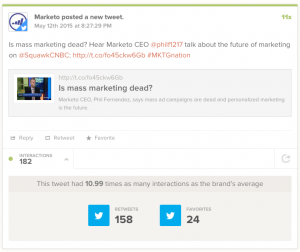 Market segmentation has traditionally been based on demographic factors such as company size, sector and location. But these simple characteristics are hopelessly inadequate predictors of which specific organisations you should focus your marketing and sales energies on.
Market segmentation has traditionally been based on demographic factors such as company size, sector and location. But these simple characteristics are hopelessly inadequate predictors of which specific organisations you should focus your marketing and sales energies on.
That’s because in any complex B2B sales environment, there will be a set of specific unique-to-you structural, behavioural and situational characteristics that are much more reliable indicators of the long-term potential of any given organisation, and of your chances of doing business with them either now or in the future.
I’m not suggesting that you should ignore demographics – but I’m urging you not to stop there when it comes to targeting your marketing efforts or assessing the attractiveness of your potential sales opportunities.
STRUCTURAL AND BEHAVIOURAL FACTORS
Common structural or behavioural characteristics often include whether the organisation behaves as an early adopter or a laggard when it comes to new ideas and technologies, whether they are a market leader or a follower, how they are funded, how they are organised (for example, centralised or decentralised), their market share ambitions, and whether their expansion strategy is through acquisition or organic growth as well which systems the organisation has already implemented.
As an example, in the early days of SaaS many of my clients learned to check whether their prospect had already implemented cloud-based systems elsewhere in their organisation, since this single data point had a huge impact on the length and complexity of the sales process and their chances of winning. Many innovative software vendors have also (through painful experience) come to recognise how important it is to test whether the prospect has a track record of buying “best-of-breed” solutions or whether they typically end up buying from established brands like SAP, IBM or Oracle.
Many of these structural and behavioural factors are usually fairly persistent – they tend not to change significantly over time, unless it is in response to a significant change in the organisation’s environment or circumstances. They are particularly useful in determining whether any organisation is likely to be a good long-term prospect.
SITUATIONAL FACTORS
But it’s the situational factors that typically indicate whether any organisation might prove to be a promising target in the here-and-now. Situational factors reflect short-term recent changes to the target organisation’s internal or external circumstances. The most common example is a recent change in management – a factor that often opens the door to change.
Other internal situational triggers can include changes in organisational focus, priorities or strategy, recent funding events or a recent acquisition, or a recent setback in the achievement of key performance indicators. External situational triggers can include recent changes in legislation or regulation, significant macro-economic changes, or a dramatic shift in the competitive landscape.
These situational triggers act as powerful catalysts for change: they disturb the status quo, and open the prospect’s eyes to the potential need for urgent change in response to the identified problem or opportunity. They drive the evaluation of new systems and new approaches, and often result in the willingness to spend money on a suitable solution.
DOING YOUR OWN RESEARCH
Of course, it’s harder to build up the relevant structural, behavioural and situational profiles than it is to buy an off-the-shelf list of “prospects” of a certain size, sector and location. But the effort invested in doing the research always has a significant payback in terms of better targeted marketing campaigns, and more effective opportunity qualification.
And that, of course, leads to finding and winning more of the right sort of prospects, shorter sales cycles, larger deal values and higher win rates.
If you haven’t already completed the exercise, here’s what I advise: start by profiling your most valuable current customers. Look for the common structural and behavioural characteristics – and ask them what situational triggers caused them to start searching for a solution. You’ll inevitably discover a number of significant patterns that could transform your marketing and sales focus.
Business & Finance Articles on Business 2 Community(54)








